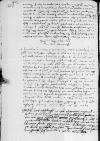List #1603
[Ioannes DANTISCUS] do Bona SforzaLöbau (Lubawa), 1537-03-16
Rękopiśmienne podstawy źródłowe:
Pomocnicze podstawy źródłowe:
Publikacje:
| ||||||||
Tekst + aparat krytyczny + komentarz Zwykły tekst Tekst + komentarz Tekst + aparat krytyczny
Serenissima Reginalis Maiestas et Domina, Domina clementissima.
Humillimam orationum et servitiorum meorum commendationem.
Ea, quae
Quod reliquum est, me gratiae Serenissimae Maiestatis Vestrae humillime commendo atque supplico, quemadmodum novissime in discessu meo Serenissima Maiestas Vestra mihi clementer ter data manu pollicita est, ne temere deinceps hominibus me deferentibus, qui nomen habere fugiunt, credat, sed me solita sua reginali benignitate ut domina mea clementissima prosequatur. Dominus Deus eandem Serenissimam Maiestatem Vestram cum tota prole regia quam diutissime sospitet prosperetque in omnibus.

 BCz, 244, p. 202
BCz, 244, p. 202